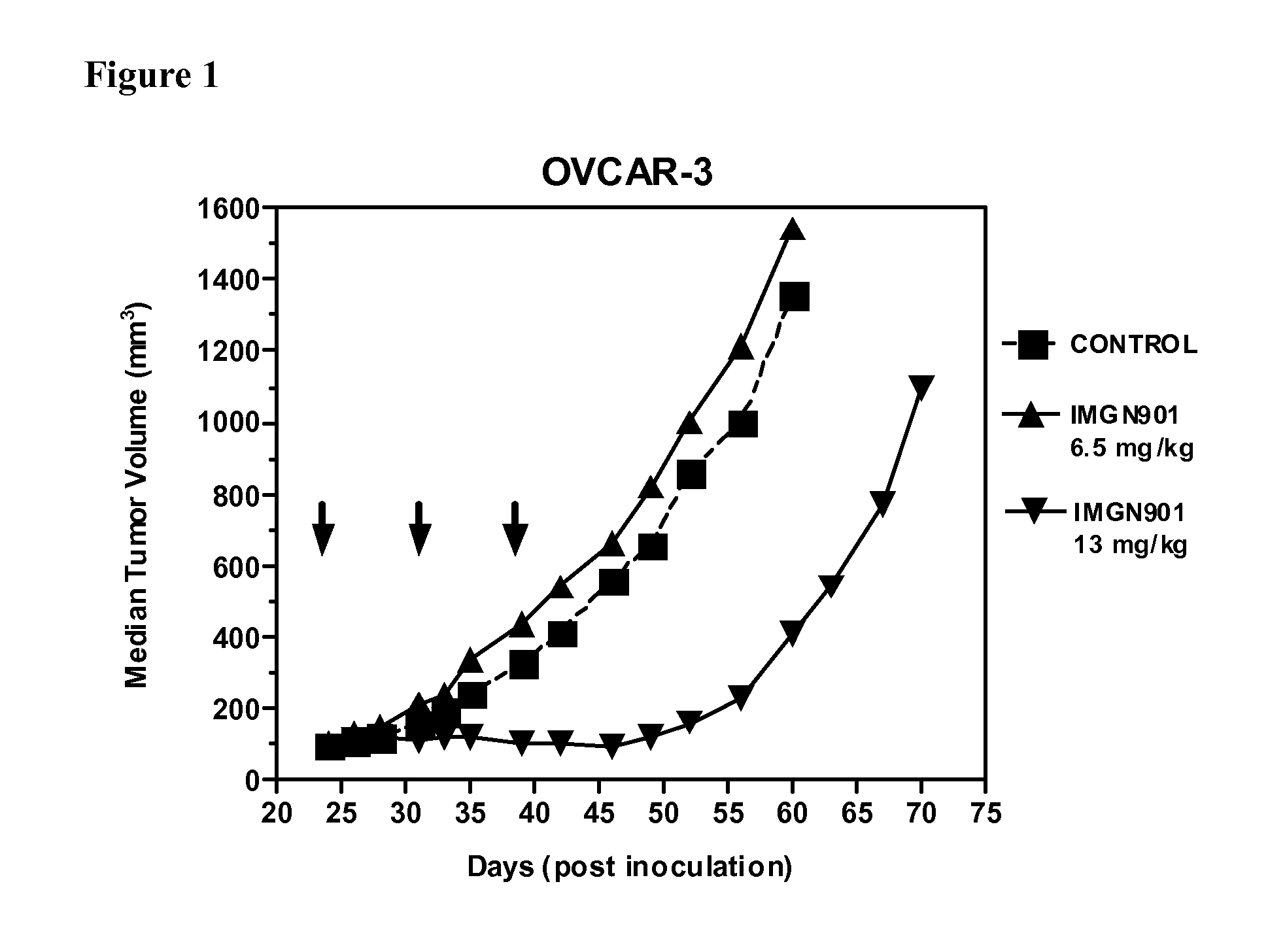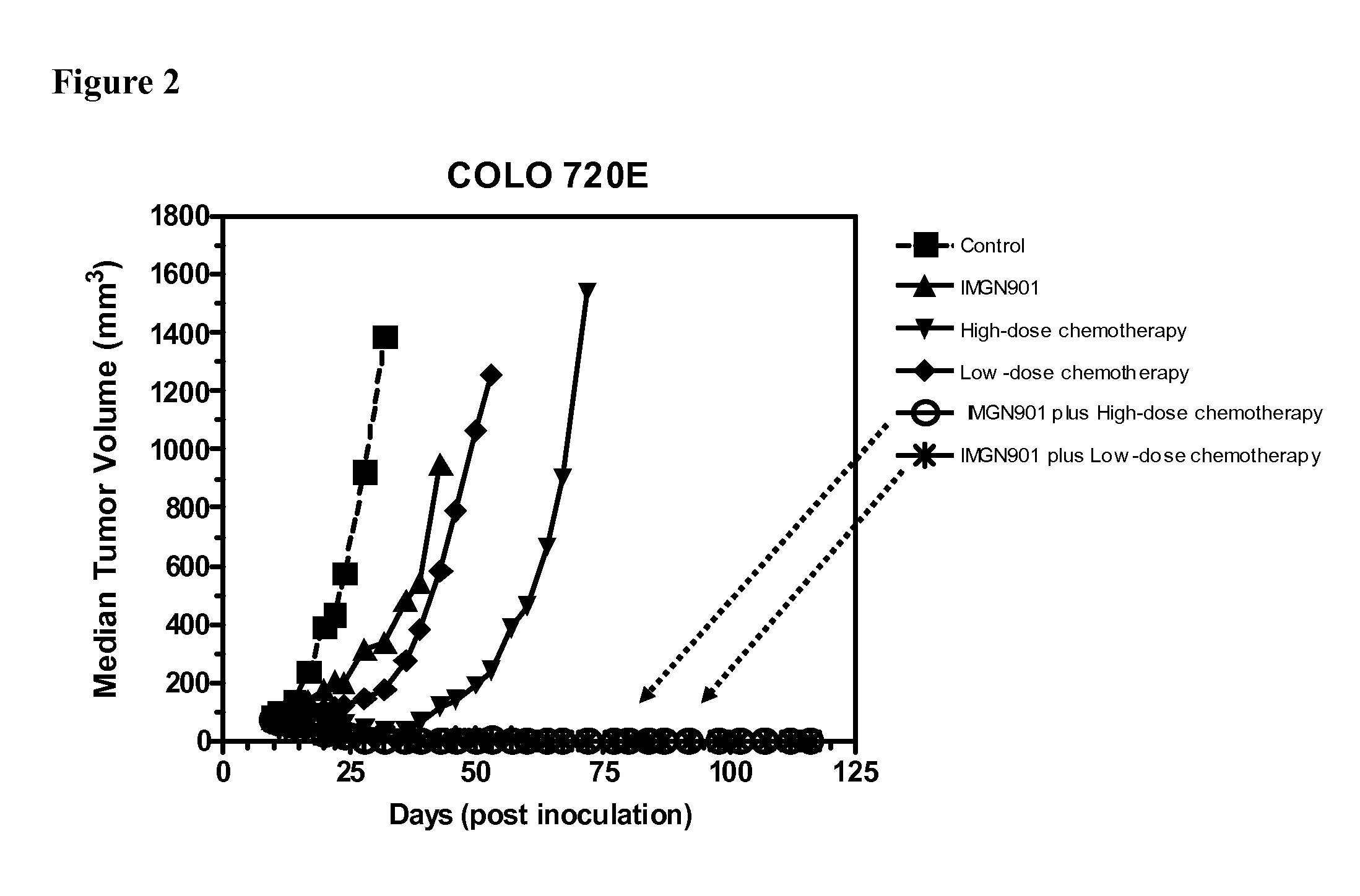Compositions and Methods for Treatment of Ovarian Cancer
- Summary
- Abstract
- Description
- Claims
- Application Information
AI Technical Summary
Benefits of technology
Problems solved by technology
Method used
Image
Examples
example 1
Anti-Tumor Effect of IMGN901 Treatment in OVCAR-3 Human Ovarian Carcinoma Xenografts
[0124]The anti-tumor effect of IMGN901 was evaluated in an established subcutaneous xenograft model of ovarian carcinoma. SCID mice were inoculated with OVCAR-3 ovarian carcinoma cells (1×107 cells / animal) injected subcutaneously into the right flank. When the tumors reached about 100 mm3 in size (24 days after tumor cell inoculation), the mice were randomly divided into three groups (6 animals per group). Mice were treated with the single agent IMGN901 at 6.5 mg / kg and 13 mg / kg, respectively, administered intravenously once weekly for three weeks (day 24, 31, 39). A control group of animals received PBS administered intravenously at the same schedule. Tumor growth was monitored by measuring tumor size twice per week. Tumor size was calculated with the formula: length×width×height×½.
[0125]FIG. 1. IMGN901 was active against OVCAR-3 tumors in terms of tumor growth inhibition (T / C=21%) at the 13 mg / kg d...
example 2
Dose-Response Anti-Tumor Activity of IMGN901 Treatment in COLO 720E Human Ovarian Carcinoma Xenografts
[0126]The anti-tumor effect of IMGN901 was evaluated in an established subcutaneous xenograft model of ovarian carcinoma. SCID mice were inoculated with COLO 720E ovarian carcinoma cells (1×107 cells / animal) injected subcutaneously into the right flank. (The COLO 720E human ovarian adenocarcinoma cell line was obtained from the European Collection of Cell Cultures (ECACC, catalog no. 93072111).) When the tumors reached about 100 mm3 in size (10 days after tumor cell inoculation), the mice were randomly divided into four groups (6 animals per group). Mice were treated with the single agent IMGN901 at 6, 12 and 24 mg / kg, respectively, administered intravenously once weekly for three weeks (day 10, 17 and 24). A control group of animals received PBS administered intravenously at the same schedule. Tumor growth was monitored by measuring tumor size twice per week. Tumor size was calcula...
example 3
Anti-Tumor Effect of Combination Therapy of COLO 720E Human Ovarian Carcinoma Xenografts with IMGN901 and Paclitaxel Plus Carboplatin
[0128]The anti-tumor effect of a combination of huN901-DM1 and paclitaxel plus carboplatin was evaluated in an established subcutaneous xenograft model of ovarian cancer. Athymic nude mice were inoculated with COLO 720E human ovarian carcinoma cells (1×107 cells / animal) injected subcutaneously into the right flank. When the tumors reached about 80 mm3 in size (10 days after tumor cell inoculation), the mice were randomly divided into six groups (6 animals per group). Mice were treated with the single agent IMGN901 at a dose of 13 mg / kg once weekly for three weeks (day 10, 17 and 24 post tumor cell inoculation) administered intravenously. Two additional groups of mice were treated with the combination chemotherapy regimen paclitaxel / carboplatin at two dose levels: a high-dose group of paclitaxel (20 mg / kg iv, weekly for 3 weeks) / carboplatin (100 mg / kg i...
PUM
| Property | Measurement | Unit |
|---|---|---|
| Composition | aaaaa | aaaaa |
| Therapeutic | aaaaa | aaaaa |
| Cytotoxicity | aaaaa | aaaaa |
Abstract
Description
Claims
Application Information
 Login to View More
Login to View More - R&D
- Intellectual Property
- Life Sciences
- Materials
- Tech Scout
- Unparalleled Data Quality
- Higher Quality Content
- 60% Fewer Hallucinations
Browse by: Latest US Patents, China's latest patents, Technical Efficacy Thesaurus, Application Domain, Technology Topic, Popular Technical Reports.
© 2025 PatSnap. All rights reserved.Legal|Privacy policy|Modern Slavery Act Transparency Statement|Sitemap|About US| Contact US: help@patsnap.com



